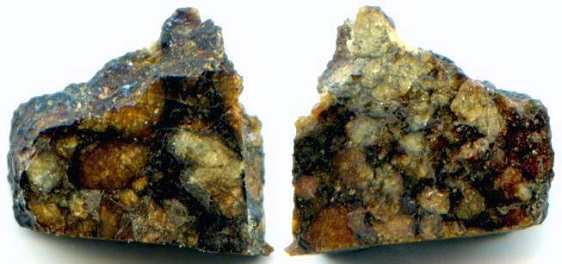NWA 7822
Achondrite-ungrouped
(dunite, CV-clan-related)
Purchased February 2013
no coordinates recorded A single fusion-crusted stone weighing 45.8 g was found in the Sahara Desert region and later sold to G. Hupé at the 2013 Tucson Gem and MineralInorganic substance that is (1) naturally occurring (but does not have a biologic or man-made origin) and formed by physical (not biological) forces with a (2) defined chemical composition of limited variation, has a (3) distinctive set of of physical properties including being a solid, and has a (4) homogeneous Click on Term to Read More Show. This meteoriteWork in progress. A solid natural object reaching a planet’s surface from interplanetary space. Solid portion of a meteoroid that survives its fall to Earth, or some other body. Meteorites are classified as stony meteorites, iron meteorites, and stony-iron meteorites. These groups are further divided according to their mineralogy and Click on Term to Read More was analyzed at the University of Washington in Seattle (A. Irving and S. Kuehner) and NWA 7822 was determined to be a dunitic lithology with olivineGroup of silicate minerals, (Mg,Fe)2SiO4, with the compositional endpoints of forsterite (Mg2SiO4) and fayalite (Fe2SiO4). Olivine is commonly found in all chondrites within both the matrix and chondrules, achondrites including most primitive achondrites and some evolved achondrites, in pallasites as large yellow-green crystals (brown when terrestrialized), in the silicate portion Click on Term to Read More FeO/MnO ratios and O-isotopic values consistent with many other diverse meteorites hypothesized to belong to an extensive CV-clan (see the O-isotopic plot; K. Ziegler, UNM). In their continued analyses of this meteorite, Sanborn et al. (2015) demonstrated that NWA 7822 plots close to the CV chondritesMeteorite class named after the Vigarano meteorite that fell in Italy in 1910. They have abundant large, well-defined rimless (?) chondrules of magnesium-rich olivine (~0.7 mm diameter; 40-65 vol. %), often surrounded by iron sulfide. They also contain 7-20 vol. % CAIs. The often dark-gray matrix is dominated by Fe-rich Click on Term to Read More on a Δ17O vs. ε54Cr coupled diagram (see diagram below). This meteorite is composed predominantly of pale-yellow olivine (>90 vol%) with a small component of interstitialTerm applied to ions or atoms occupying sites between lattice points. Click on Term to Read More clinopyroxene and plagioclaseAlso referred to as the plagioclase feldspar series. Plagioclase is a common rock-forming series of feldspar minerals containing a continuous solid solution of calcium and sodium: (Na1-x,Cax)(Alx+1,Si1-x)Si2O8 where x = 0 to 1. The Ca-rich end-member is called anorthite (pure anorthite has formula: CaAl2Si2O8) and the Na-rich end-member is albite Click on Term to Read More, along with low abundances of the typical opaque phases (taeniteLess common than kamacite, both taenite and kamacite are Ni-Fe alloys found in iron meteorites. Taenite, γ-(Fe,Ni), has 27-65 wt% Ni, and forms small crystals that appear as highly reflecting thin ribbons on the etched surface of a meteorite; the name derives from the Greek word for "ribbon." Click on Term to Read More, troiliteBrass colored non-magnetic mineral of iron sulfide, FeS, found in a variety of meteorites. Click on Term to Read More, and chromiteBrownish-black oxide of chromium and iron (Cr-Fe oxide), Cr2FeO4, found in many meteorite groups. Click on Term to Read More).
Collisional Disruption of a Primary Planetary Body
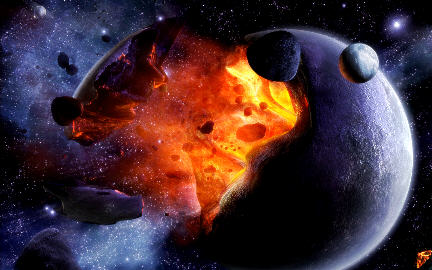
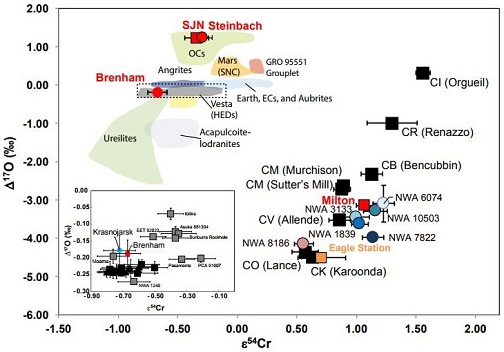
click on image for a magnified view Diagram credit: Sanborn et al., 49th LPSC, #1780 (2018) Notably, a formation scenario for pallasites was proposed by Asphaug et al. (2006) and Danielson et al. (2009) in which the wide variation in metal–silicate textures and bulk compositions that is observed among MG pallasite members is the result of a grazing collision between partially molten planetary embryos. They assert that such a collision resulted in the formation of a chain of smaller objects having diverse compositions. It might be more than coincidental that the O-isotopic composition of the Milton pallasite plots proximate to the trend line of the Eagle Station group pallasites (now termed the Allende Mixing line: slope = 0.94 ±0.01). Both of these rapidly-cooled pallasites contain high concentrations of the refractory siderophile elementLiterally, "iron-loving" element that tends to be concentrated in Fe-Ni metal rather than in silicate; these are Fe, Co, Ni, Mo, Re, Au, and PGE. These elements are relatively common in undifferentiated meteorites, and, in differentiated asteroids and planets, are found in the metal-rich cores and, consequently, extremely rare on Ir relative to main-group (MG) pallasites (Jones et al., 2003), and they both have overlapping Fe and Ni abundances (wt%) in their metalElement that readily forms cations and has metallic bonds; sometimes said to be similar to a cation in a cloud of electrons. The metals are one of the three groups of elements as distinguished by their ionization and bonding properties, along with the metalloids and nonmetals. A diagonal line drawn Click on Term to Read More component; however, significant variations observed in their minor and trace elementSubstance composed of atoms, each of which has the same atomic number (Z) and chemical properties. The chemical properties of an element are determined by the arrangement of the electrons in the various shells (specified by their quantum number) that surround the nucleus. In a neutral atom, the number of Click on Term to Read More concentrations indicate that they each experienced different crystallizationPhysical or chemical process or action that results in the formation of regularly-shaped, -sized, and -patterned solid forms known as crystals. Click on Term to Read More processes (Hillebrand, 2004). Still, there is a good possibility that one or both of these pallasites did share a common precursor parent body with the CV clan of meteorites, at least prior to any collisional disruption event.

Diagram adapted from Korochantsev et al., 2013 With the advent of better investigative techniques, scientists have explored the possibility of a genetic relationship between IVB irons and other meteorite groups based on O-isotopic analyses. Utilizing chromite grains from IVB irons Warburton Range and Hoba, Corrigan et al. (2017) found that IVB irons share close similarities to the South Byron trio irons (Babb’s Mill [Troost’s], South Byron, and Inland Forts [ILD] 83500)–Milton pallasite grouping (MSB in diagram below). Moreover, the O-isotopic compositions of the IVB irons and the South Byron trio–Milton grouping fallMeteorite seen to fall. Such meteorites are usually collected soon after falling and are not affected by terrestrial weathering (Weathering = 0). Beginning in 2014 (date needs confirmation), the NomComm adopted the use of the terms "probable fall" and "confirmed fall" to provide better insight into the meteorite's history. If Click on Term to Read More within the range of the oxidizedOxidation and reduction together are called redox (reduction and oxidation) and generally characterized by the transfer of electrons between chemical species, like molecules, atoms or ions, where one species undergoes oxidation, a loss of electrons, while another species undergoes reduction, a gain of electrons. This transfer of electrons between reactants Click on Term to Read More CV and CK chondrites.

Diagram credit: Corrigan et al., 48h LPSC, #2556 (2017) Subsequent to the catastrophic disruption of the primary planetary body that is envisioned here, and the sorting and re-accretion of material into a number of daughter objects, multiple impacts onto these small asteroids could have led to the formation of sub-surface melt pools tens of meters in size. Differentiation of these melt pools would have resulted in cumulus olivine sequestered above a metal layer, and an olivine residuum that had drained below this metal layer—a complex assemblage from which associated pallasitic and silicated-iron lithologies could be derived thereafter during less-energetic, rapidly-cooled impact events (Malvin et al., 1985). The anomalously-high Ir contents measured in some of the associated metal–silicate mixtures (e.g., Eagle Station grouplet, Milton) and segregated metal regions (IIF irons, South Byron trio) would be consistent with metal that crystallized at the lowest levels of the melt chamber. Such late-stage, rapidly-cooled, impact-heating events could have allowed for the retention of the original O- and Cr-isotopic composition of the primary planetary body (Humayun and Weiss, 2011 and references therein). The differences that exist in δ54Cr between chromite and olivine in the Eagle Station pallasite, but which are not observed in CV chondrites, could be the result of a distinct Cr source associated with impact projectile(s) which eventually led to the formation of the Eagle Station-type pallasites and other related lithologies (Papanastassiou and Chen (2011). On an oxygen three-isotope diagram (see example below), the CO chondrites plot along the Allende Mixing trend line (former CCAM line), overlapping near the middle of the CV chondrite field. There is a possibility that the CO chondriteMeteorite class named after the Ornans meteorite that fell in France in 1868, are related in chemistry and composition to the CV chondrites and may, with them, represent a distinct clan of carbonaceous chondrites that formed in the same region of the early solar system. However, COs are usually blacker Click on Term to Read More group, of which Isna is a marginally equilibrated example (type 3.75), is also implicated in the sequence of events that led to the formation of the diverse CV clan of meteorites as outlined above—perhaps as another of the daughter objects that accreted after a catastrophic disruption of the primary planetary body. It could be deduced that subsequent impacts involving many of these daughter objects sent fragments into storage orbits within the outer asteroid beltBelt located between 2.12 and 3.3 AU from the Sun and located between the orbits of Mars and Jupiter containing the vast majority of asteroids. The asteroid belt is also termed the main asteroid belt or main belt to distinguish it from other asteroid populations in the Solar System such Click on Term to Read More. Further fragmentation events (collisional cascade processes), along with the Yarkovsky effect, would have delivered samples into mean motion resonances with some fragments eventually achieving Earth-crossing orbits.
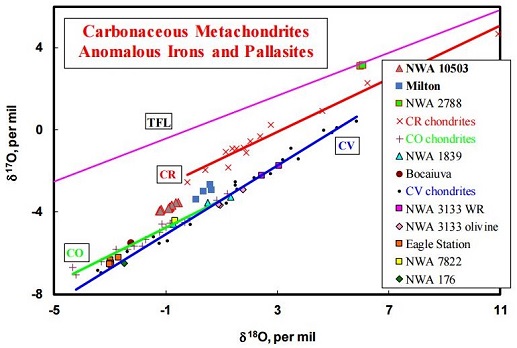
click on image for a magnified view Diagram credit: Irving et al., 79th MetSoc, #6461 (2016) The hypothesis of multiple daughter objects being formed following the catastrophic disruption of a large, partially differentiated, primary planetary body could allow for the potential inclusionFragment of foreign (xeno-) material enclosed within the primary matrix of a rock or meteorite. Click on Term to Read More of several less closely-related meteorites. These may include the high-Ni irons of the South Byron trio (South Byron, ILD 83500, and Babb’s Mill), which have metallographic compositions (especially siderophile element patterns) and structures similar to the metal in Milton, including kamaciteMore common than taenite, both taenite and kamacite are Ni-Fe alloys found in iron meteorites. Kamacite, α-(Fe,Ni), contains 4-7.5 wt% Ni, and forms large body-centered cubic crystals that appear like broad bands or beam-like structures on the etched surface of a meteorite; its name is derived from the Greek word Click on Term to Read More spindles and associated schreibersiteNi-Fe phosphide mineral, (Fe,Ni)3P, yellowish in color and predominantly found in iron and stony-iron meteorites. Schreibersite can also be found in a variety of other meteorites including some acapulcoites, aubrites, enstatite chondrites and achondrites, lunars, ureilites, winonaites and a smattering of other meteorite types like CM, CO and CB. Schreibersite Click on Term to Read More, consistent with their formation on the same parent body (Reynolds et al., 2006). These three irons and the metal component in Milton experienced a similar oxidationOxidation and reduction together are called redox (reduction and oxidation) and generally characterized by the transfer of electrons between chemical species, like molecules, atoms or ions, where one species undergoes oxidation, a loss of electrons, while another species undergoes reduction, a gain of electrons. This transfer of electrons between reactants Click on Term to Read More history during formation; they each have similar depletions of easily oxidized elements as well as similar abundances of siderophiles (McCoy et al., 2008). In addition to the irons mentioned above, several other ungroupedModifying term used to describe meteorites that are mineralogically and/or chemically unique and defy classification into the group or sub-group they most closely resemble. Some examples include Ungrouped Achondrite (achondrite-ung), Ungrouped Chondrite (chondrite-ung), Ungrouped Iron (iron-ung), and Ungrouped Carbonaceous (C-ung). Click on Term to Read More ataxites may be genetically related to this high-Ni iron group, including El Qoseir, Illinois Gulch, Morradal, Nordheim, and Tucson (Kissin, 2010). However, significant differences that exist between their refractory element contents compared to those of the South Byron trio requires further work to establish a specific relationship. The metal in each of these high-Ni iron meteorites and in Milton is consistent with early crystallization from a metallic-melt phase that experienced a low degree of fractionationConcentration or separation of one mineral, element, or isotope from an initially homogeneous system. Fractionation can occur as a mass-dependent or mass-independent process. Click on Term to Read More. Similarly, the FeNi-metal component of one member of the Eagle Station grouplet, Itzawisis, was derived from a metallic-melt source consistent with that of a differentiated, oxidized-CV source before 20% fractionation had occurred. In a like manner, the metal in Eagle Station derives from a 20% fractionated source (Humayun and Weiss, 2011), while another member of the grouplet, Cold Bay, was shown to derive from a melt source that crystallized after 40% fractionation. The most recent member of the Eagle Station grouplet to be analyzed, Karavannoe, crystallized from an even more evolved metallic-melt that had undergone >60% fractionation—though still not as evolved as the source melt from which MG pallasite metal crystallized. Karavannoe FeNi-metal has a lower Ni content than the other members of the grouplet (Korochantsev et al., 2013), and measurements show that its Ir content is intermediate between that of Eagle Station and Milton. Further evidence for a large differentiated planetary body having CV-trends lies in the fact that CV chondrites acquired a strong unidirectional natural remanent magnetization ~9 m.y. after CAI formation, reflecting the existence of an internal core dynamo (e.g., Weiss et al., 2010; Elkins-Tanton et al., 2011; Carporzen et al., 2010, 2011; Gattacceca et al., 2013, 2016). Employing multiple investigation techniques, Shah et al. (2017) investigated the paleointensity of 19 Vigarano chondrulesRoughly spherical aggregate of coarse crystals formed from the rapid cooling and solidification of a melt at ~1400 ° C. Large numbers of chondrules are found in all chondrites except for the CI group of carbonaceous chondrites. Chondrules are typically 0.5-2 mm in diameter and are usually composed of olivine Click on Term to Read More and found values of 1.1–150 µT. The observed magnetic remanence is considered to have been acquired during brecciationThe formation of a breccia through a process by which rock fragments of of various types are recemented or fused together. Click on Term to Read More events that occurred ~7 m.y. after initial parent body accretionAccumulation of smaller objects into progressively larger bodies in the solar nebula leading to the eventual formation of asteroids, planetesimals and planets. The earliest accretion of the smallest particles was due to Van der Waals and electromagnetic forces. Further accretion continued by relatively low-velocity collisions of smaller bodies in the Click on Term to Read More, with impact shock pressures reaching 10–20 GPa. Therefore, they reason that the original paleofield would have been ~40 µT, which is too high to be attributable to the solar windSupersonic flow of high-speed charged particles continuously blowing off a star (mostly e- and p+). When originating from stars other than the Sun, it is sometimes called a "stellar" wind. The solar wind may be viewed as an extension of the corona into interplanetary space. The solar wind emanates radially field, but is in the range of that expected for a planetary core dynamo. As research continues, further evidence for the catastrophic disruption of this former primary body could advance this hypothesis (see the Allende page for further paleomagnetic information). The photo shown above is a 1.0 g partial slice of the dunite NWA 7822, while photos of a complete slice and the original stone are shown below.
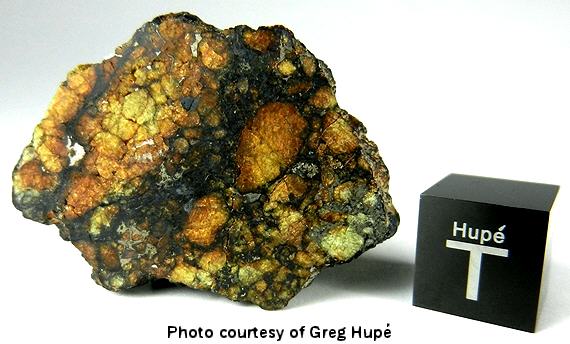

Photos courtesy of Greg Hupé—Nature’s Vault






